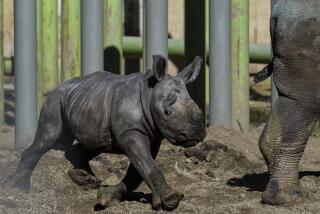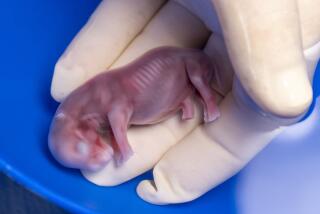Relocated Rhinos Thriving and Reproducing in Nepal
- Share via
LAMKULI PHANTA, Nepal — Tiny footprints recently led wildlife officials to a baby rhinoceros, the first calf born to a herd transplanted to this swampy area from another part of Nepal to preserve them.
“We had initially not expected a baby so soon here when we put the rhinos for the first time in this jungle,” said Krisha Man Shrestha, the jubilant warden of Royal Bardia Wildlife Reserve.
“We came to know about the new arrival when we first saw the footprints of the baby rhino. We followed the tracks and found the mother and the baby in good health.”
Thirteen rhinoceroses have been transported to the Bardia reserve since 1986 from the Chitwan sanctuary, 220 dusty miles to the east, because naturalists feared that it was too risky to leave the endangered animals in just one area where a single epidemic could wipe them out. The move was made with the assistance of the World Wildlife Fund.
The reserve, 406 miles southwest of Katmandu, Nepal’s capital, is similar to Chitwan with its tropical lowland and thick highland forest.
“In the first year we took only four because we felt translocating animals of this size was a logistics nightmare,” said Hemant Raj Mishra, a noted Nepalese naturalist. “It (the relocation) has never been done before in Asia.”
The rhinos previously had been found only in the Chitwan valley, 75 miles southwest of Katmandu in Nepal’s southern plains, and in Kaziranga in the east Indian state of Assam. Kaziranga now has the most--1,000 to 1,200--of the one-horned rhinos, the second largest of the five species of rhinos.
Poaching Depleted Numbers
Rhino horns remain in great demand in Asia and the Middle East, where they are carved into dagger handles or ground to dust to be sold as an aphrodisiac. Consequently, wanton hunting and poaching had depleted their number to about 100 in the Chitwan area.
In 1967, an aerial survey by the U.N. Food and Agriculture Organization estimated that only 90 to 108 rhinos remained in Chitwan, and only 5% of the females had calves--an indication that their number was declining.
Nepalese officials implemented strict measures to protect the animals, and their numbers increased to between 350 and 370 in 1986. Officials also found 70% of the females had calves, a sign of healthy growth in the population.
More to Read
Sign up for Essential California
The most important California stories and recommendations in your inbox every morning.
You may occasionally receive promotional content from the Los Angeles Times.













